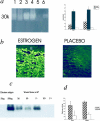Topical estrogen accelerates cutaneous wound healing in aged humans associated with an altered inflammatory response
- PMID: 10514397
- PMCID: PMC1867002
- DOI: 10.1016/S0002-9440(10)65217-0
Topical estrogen accelerates cutaneous wound healing in aged humans associated with an altered inflammatory response
Abstract
The effects of intrinsic aging on the cutaneous wound healing process are profound, and the resulting acute and chronic wound morbidity imposes a substantial burden on health services. We have investigated the effects of topical estrogen on cutaneous wound healing in healthy elderly men and women, and related these effects to the inflammatory response and local elastase levels, an enzyme known to be up-regulated in impaired wound healing states. Eighteen health status-defined females (mean age, 74.4 years) and eighteen males (mean age, 70.7 years) were randomized in a double-blind study to either active estrogen patch or identical placebo patch attached for 24 hours to the upper inner arm, through which two 4-mm punch biopsies were made. The wounds were excised at either day 7 or day 80 post-wounding. Compared to placebo, estrogen treatment increased the extent of wound healing in both males and females with a decrease in wound size at day 7, increased collagen levels at both days 7 and 80, and increased day 7 fibronectin levels. In addition, estrogen enhanced the strength of day 80 wounds. Estrogen treatment was associated with a decrease in wound elastase levels secondary to reduced neutrophil numbers, and decreased fibronectin degradation. In vitro studies using isolated human neutrophils indicate that one mechanism underlying the altered inflammatory response involves both a direct inhibition of neutrophil chemotaxis by estrogen and an altered expression of neutrophil adhesion molecules. These data demonstrate that delays in wound healing in the elderly can be significantly diminished by topical estrogen in both male and female subjects.
Figures







References
-
- Ashcroft GS, Horan MA, Herrick SE, Tarnuzzer RW, Schultz GS, Ferguson MWJ: Age-related differences in the temporal and spatial regulation of Matrix Metalloproteinases (MMPs) in normal skin and acute cutaneous wounds of healthy humans. Cell Tissue Res 1997, 290:581-591 - PubMed
-
- Herrick SE, Ashcroft GS, Ireland G, Horan MA, McCollum C, Ferguson MWJ: Up-regulation of elastase in acute wounds of healthy aged humans and chronic venous leg ulcers is associated with matrix degradation. Lab Invest 1996, 77:281-288 - PubMed
-
- McDonald JA, Kelley DG: Degradation of fibronectin by human leucocyte elastase. J Biol Chem 1980, 255:8848-8858 - PubMed
Publication types
MeSH terms
Substances
LinkOut - more resources
Full Text Sources
Other Literature Sources

